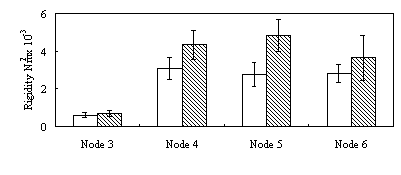Introduction
Plants can also respond locally to mechanical stimulation. In sunflowers, the more highly stressed areas such as the base of the stem and roots, have been shown to respond the most to mechanical stimulation (Goodman and Ennos, 1997; 1998).
The effects of local mechanical stimulation on local root growth in maize (Zea mays L.), growing in an aerated nutrient solution, was also investigated (Goodman and Ennos, 2001). The morphology and mechanical properties of primary nodal roots were compared between those which underwent a programme of flexing and those which received no mechanical stimulation.
Results
Local mechanical stimulation had limited effects on the morphology of maize nodal roots; there was no significant effect of flexing on the diameter of primary nodal roots when compared to untreated roots. However, there were significant differences in root mass between treatments; there was a large decrease of 43% in the fresh and 41% in the dry mass of the fine roots in the flexed roots compared with the untreated roots. Surprisingly there was only a small effect on the mass of the primary nodal roots: only at the fifth node was there a significant increase of 15% in the dry mass of flexed roots compared to those which received no mechanical stimulation.
The effects of root flexure on the mechanical properties of the roots was more dramatic. Roots at both nodes four and five were significantly more rigid (Fig. 1), stronger and composed of a stiffer material than those which received no mechanical stimulation.

After flexing, the primary nodal roots at the fifth node showed increases of 75% in the rigidity (Fig. 1), 60% in the bending strength and 70% in the bending modulus of the flexed roots compared to unstimulated roots.
Conclusion
This study shows that :
- the thigmomorphogenetic response, at least in maize roots, can be localised even down to individual roots and not just to regions of the root system.
- individual roots are able to respond independently to mechanical stimulation.
The ecological significance of this may be that adaptive ‘fine tuning’ of individual roots to mechanical stimulation may produce plants which are better able to withstand overturning forces and prevent anchorage failure. This local response may also enable plants to respond, more effectively, to fluctuations in the mechanical impedance of the soil, which may result from compaction by animals or vehicles, or by the presence of naturally compacted horizons.
Future work
This could allow future studies to:
- compare the effects of timing and the level of mechanical stimulation on the growth of primary nodal roots (which serve a primary anchorage role), and the fine roots which are important in nutrient acquisition and water uptake.
- better investigate the physiology and molecular biology of thigmomorphogenesis. It may be possible, by comparing stressed and unstressed areas of a single plant, to better identify genes involved in the response and follow the production and metabolism of messages such as ethylene.
For further information click here: (Goodman and Ennos, 2001).

